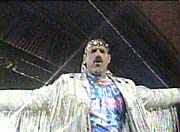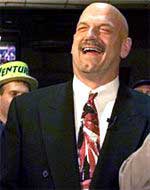PR professionals the world over must be scratching their heads at the sudden surge of interest in sprawl. The topic has all the sex appeal of a zoning meeting or a traffic jam — being about zoning meetings and traffic jams — and its number-one spokesperson is V. (as in vanilla) P. Al Gore. The planet almost tilts as the viewing public reaches en masse for their remotes, surfing for something more entertaining — say, professional wrestling.

Jesse spreads his wings.
They’re in for a surprise when they get there, because now entering the ring in an epic Brawl Against Sprawl is Minnesota Gov. Jesse “The Body” Ventura. Last Friday, Ventura addressed sprawl activists gathered in Minneapolis from around the country, endorsing a comprehensive smart growth package for his home state. “When so often citizens get stuck in those traffic jams, they feel powerless,” said Ventura, tapping the populist vein that won him office. “If I can steal a quote from our NFL coach Denny Green, there’s a new sheriff in town.”
At first glance, the libertarian-leaning Ventura seems an unlikely champion of smart growth. Election polls show he fared poorly among people with postgraduate degrees — i.e., the same wonkish crowd that gave him such a warm reception last week at the Minneapolis Convention Center. But Ventura’s historic gubernatorial victory in last fall’s elections coincided with a nationwide vote that also catapulted sprawl into the political limelight. In that election, some 240 sprawl-related initiatives were on state and local ballots, and 72 percent passed. Ventura is hardly in the vanguard as more than 30 governors have muttered smart growth mantras this year alone.
Meanwhile, Ventura has spent the last month weathering the racier admissions contained in his new autobiography I Ain’t Got Time To Bleed. Among the contretemps are his tale of losing his virginity at age 16, dalliances with prostitutes, using marijuana and steroids, and not wearing any underwear. “What kind of a role model is this for our kids?” the skeptics ask.
Ventura might do well to turn this criticism on its head by redirecting it toward American cities. After all, much of our sprawling landscape looks like the American Dream on steroids, and who among us hasn’t driven a particularly useless frontage road and wondered if the traffic engineers had been high at their drafting tables? What communities haven’t prostituted themselves with tax breaks, flipping their zoning skirts for developers? And as for the kids, in the wake of the Columbine shootings, people are starting to wonder aloud whether our current development patterns are failing the youth of America. Ventura may not wear underwear, but the emperors of America’s subdivisions are suddenly wearing no clothes.
Choo-choo on This, Developers
“It’s been impossible to talk about land use in the United States because our paradigm has been that we’ll talk about it when we run out of land,” says Roy Kienitz, executive director of the Washington, D.C.-based Surface Transportation Policy Project (STPP). “Finally, I think people are realizing that even when you have more land, there are still good reasons not to sprawl. It’s very much like the growing-up process. At first, the fact that you can stay out till five in the morning and drink too much means that you will, but when you get older you realize that just because you can do it doesn’t mean you should do it.”

The American dream on steroids.
Ventura didn’t make sprawl a central issue in his campaign, but he indicated his willingness to rock the land-use boat when he made rail transit one of his top five priorities in his state of the state address in March. Gore would have packaged this proclamation in a bundle of statistics about infrastructure and efficiency and growing our economy, but Ventura was the soul of wit: “I want to ride a train by 2002,” he said simply. “I’ll know we’re successful when I can ride light rail from downtown Minneapolis to the megamall and take commuter rail from St. Cloud to the Twin Cities. ” Then he stared down a hostile legislature to get the $60 million necessary to make it happen.
Ventura has also signaled his intentions with strong growth management appointments. To run the Metropolitan Council, the unique regional body that helps coordinate governance in the seven counties surrounding the Twin Cities, he chose wannabe-governor Ted Mondale. “I wasn’t actually running for governor, I was running for Met Council,” joked Mondale, who brought up the rear in a five-way Democratic-Farmer-Labor primary despite his pedigree as the son of former Vice Pres. Walter Mondale. “What you do is you get so few votes that the winner doesn’t fear you.” Mondale has already begun throwing the Met Council’s weight around in an effort to live up to Ventura’s challenge to prove the agency’s worth.
Then there is Elwyn Tinklenberg, the new commissioner for the Minnesota Department of Transportation, whose unfortunate resemblance to Donald Trump can be forgiven due to his self-effacing sense of humor and the years he spent as a Methodist minister. Tinklenberg originally endorsed Mondale and then voted for Ventura’s opponent in the general election, but he has known Ventura since they were both mayors of northern Minneapolis suburbs and worked together on local transportation issues.
As Ventura proudly tells it, the walls over at MnDOT used to be covered with beautiful pictures of roads, bridges, and interchanges. One of Tinklenberg’s first symbolic gestures was to order some new pictures: of shiny new light-rail tracks, trains, and people movers.
“When all you have is a hammer, everything looks like a nail,” Tinklenberg said of his agency’s asphalt addiction. Folk wisdom, yes, but applied to DOTs across the country it’s nearly profound. The complaint is that between an ossified engineering culture and federal funding mechanisms that until recently funded practically nothing but pavement, it’s no surprise that everything a DOT touches turns to pavement.
“The head of the Texas DOT doesn’t say things like that,” commented a heartened Kienitz to Tinklenberg. “Maybe the next time you see him, you can have a couple words with him.”
Jesse Delivers the Final Punch
All things considered, the conferees were in high spirits by the time they assembled to hear Ventura’s valedictory. “Be nice to our governor,” Mondale had asked earlier. “It will be exciting. You never know what he’s going to say.”
Overall the speech was uneventful, filled with smart growth catch phrases about farmland preservation and integrating land use and transportation. Then The Body, dressed down in blue jeans and a workshirt, dropped one of his ad-lib pearls to keep the scribes busy: “We can accomplish some remarkable things here in the state of Minnesota so that the year 2010, 2015, or 2020 or whatever it might be, they will look back and say — much as what they say when you look at the inauguration, because you know, every First Lady’s dress gets put into the historical society. … And rest assured 100 years from now, when they look back to the year 1999, they’re going to look at that dress the First Lady wore and they’re going to go, ‘What in the Hell happened?’ Because her dress is a little bit different. … I want them to look back and say, ‘What happened in 1999?’ What we are going to do is right and we will be judged later by generations to come. I think they’ll be very proud of the decisions we’re looking forward to today to make Minnesota the great place it is.”
Grist is still trying to track down the specifics on the First Lady’s dr
ess, as well as rumors that Tipper Gore was last seen canvassing the Mall of America for a tailor. But you’ve got to hand it to Jesse: He really knows how to court the soccer mom vote. How does he do it? The answer is in his autobiography: “The bottom line is that my opponents were boring.”


